Food Insecurity and Its Adverse Effects on Health and Well-being
VerifiedAdded on 2022/10/15
|9
|2272
|452
AI Summary
This article discusses the adverse effects of food insecurity on health and well-being, especially in New Zealand. It highlights the prevalence of food insecurity in socioeconomically disadvantaged communities and families. It also suggests interventions to tackle the problem, such as community approaches, subsidies, and taxation measures. The article emphasizes the need for collaboration between the government and the population to fix the problem of food insecurity.
Contribute Materials
Your contribution can guide someone’s learning journey. Share your
documents today.

Running head: WRITING AND INQUIRY 1
Writing and Inquiry
Writing and Inquiry
Secure Best Marks with AI Grader
Need help grading? Try our AI Grader for instant feedback on your assignments.
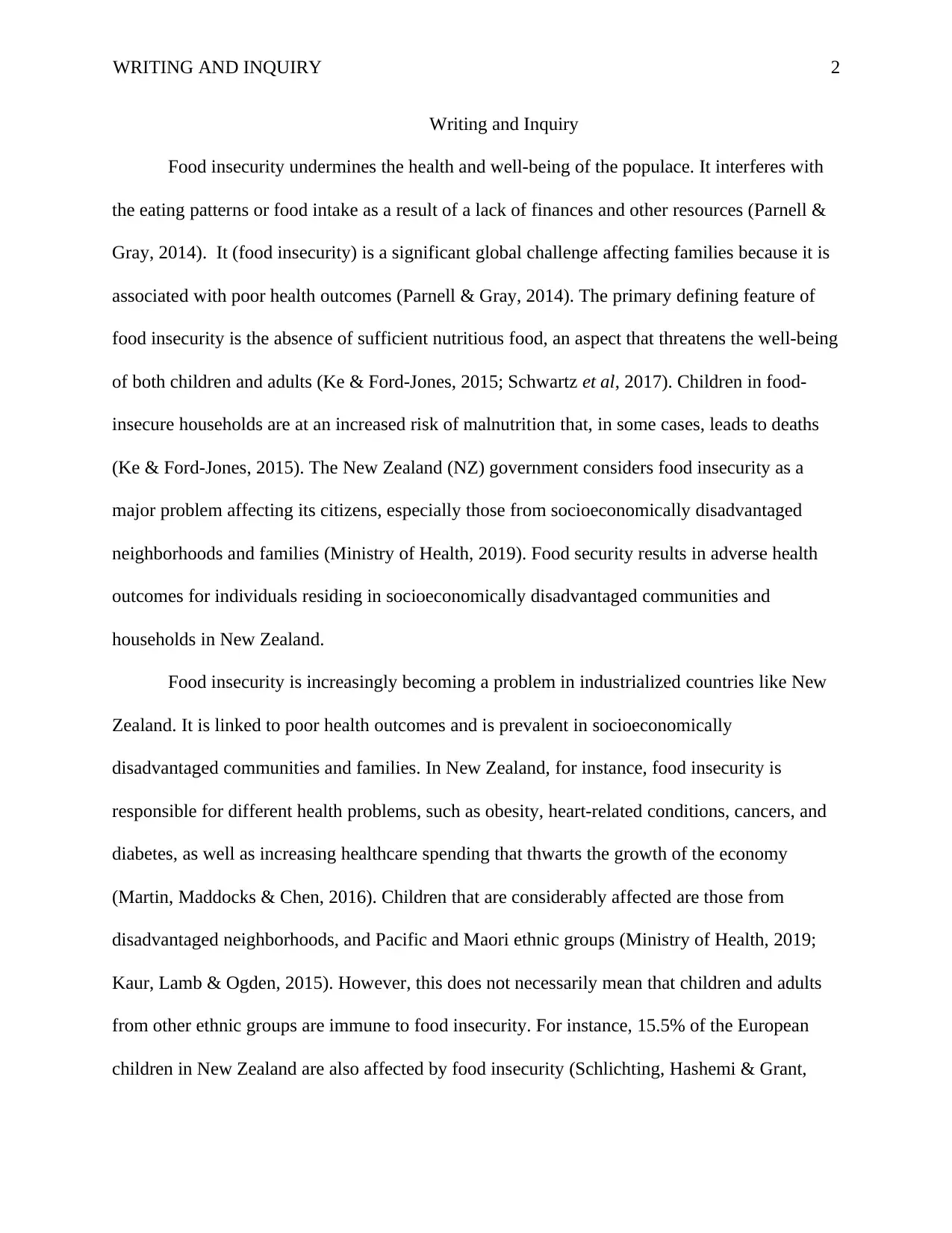
WRITING AND INQUIRY 2
Writing and Inquiry
Food insecurity undermines the health and well-being of the populace. It interferes with
the eating patterns or food intake as a result of a lack of finances and other resources (Parnell &
Gray, 2014). It (food insecurity) is a significant global challenge affecting families because it is
associated with poor health outcomes (Parnell & Gray, 2014). The primary defining feature of
food insecurity is the absence of sufficient nutritious food, an aspect that threatens the well-being
of both children and adults (Ke & Ford-Jones, 2015; Schwartz et al, 2017). Children in food-
insecure households are at an increased risk of malnutrition that, in some cases, leads to deaths
(Ke & Ford-Jones, 2015). The New Zealand (NZ) government considers food insecurity as a
major problem affecting its citizens, especially those from socioeconomically disadvantaged
neighborhoods and families (Ministry of Health, 2019). Food security results in adverse health
outcomes for individuals residing in socioeconomically disadvantaged communities and
households in New Zealand.
Food insecurity is increasingly becoming a problem in industrialized countries like New
Zealand. It is linked to poor health outcomes and is prevalent in socioeconomically
disadvantaged communities and families. In New Zealand, for instance, food insecurity is
responsible for different health problems, such as obesity, heart-related conditions, cancers, and
diabetes, as well as increasing healthcare spending that thwarts the growth of the economy
(Martin, Maddocks & Chen, 2016). Children that are considerably affected are those from
disadvantaged neighborhoods, and Pacific and Maori ethnic groups (Ministry of Health, 2019;
Kaur, Lamb & Ogden, 2015). However, this does not necessarily mean that children and adults
from other ethnic groups are immune to food insecurity. For instance, 15.5% of the European
children in New Zealand are also affected by food insecurity (Schlichting, Hashemi & Grant,
Writing and Inquiry
Food insecurity undermines the health and well-being of the populace. It interferes with
the eating patterns or food intake as a result of a lack of finances and other resources (Parnell &
Gray, 2014). It (food insecurity) is a significant global challenge affecting families because it is
associated with poor health outcomes (Parnell & Gray, 2014). The primary defining feature of
food insecurity is the absence of sufficient nutritious food, an aspect that threatens the well-being
of both children and adults (Ke & Ford-Jones, 2015; Schwartz et al, 2017). Children in food-
insecure households are at an increased risk of malnutrition that, in some cases, leads to deaths
(Ke & Ford-Jones, 2015). The New Zealand (NZ) government considers food insecurity as a
major problem affecting its citizens, especially those from socioeconomically disadvantaged
neighborhoods and families (Ministry of Health, 2019). Food security results in adverse health
outcomes for individuals residing in socioeconomically disadvantaged communities and
households in New Zealand.
Food insecurity is increasingly becoming a problem in industrialized countries like New
Zealand. It is linked to poor health outcomes and is prevalent in socioeconomically
disadvantaged communities and families. In New Zealand, for instance, food insecurity is
responsible for different health problems, such as obesity, heart-related conditions, cancers, and
diabetes, as well as increasing healthcare spending that thwarts the growth of the economy
(Martin, Maddocks & Chen, 2016). Children that are considerably affected are those from
disadvantaged neighborhoods, and Pacific and Maori ethnic groups (Ministry of Health, 2019;
Kaur, Lamb & Ogden, 2015). However, this does not necessarily mean that children and adults
from other ethnic groups are immune to food insecurity. For instance, 15.5% of the European
children in New Zealand are also affected by food insecurity (Schlichting, Hashemi & Grant,
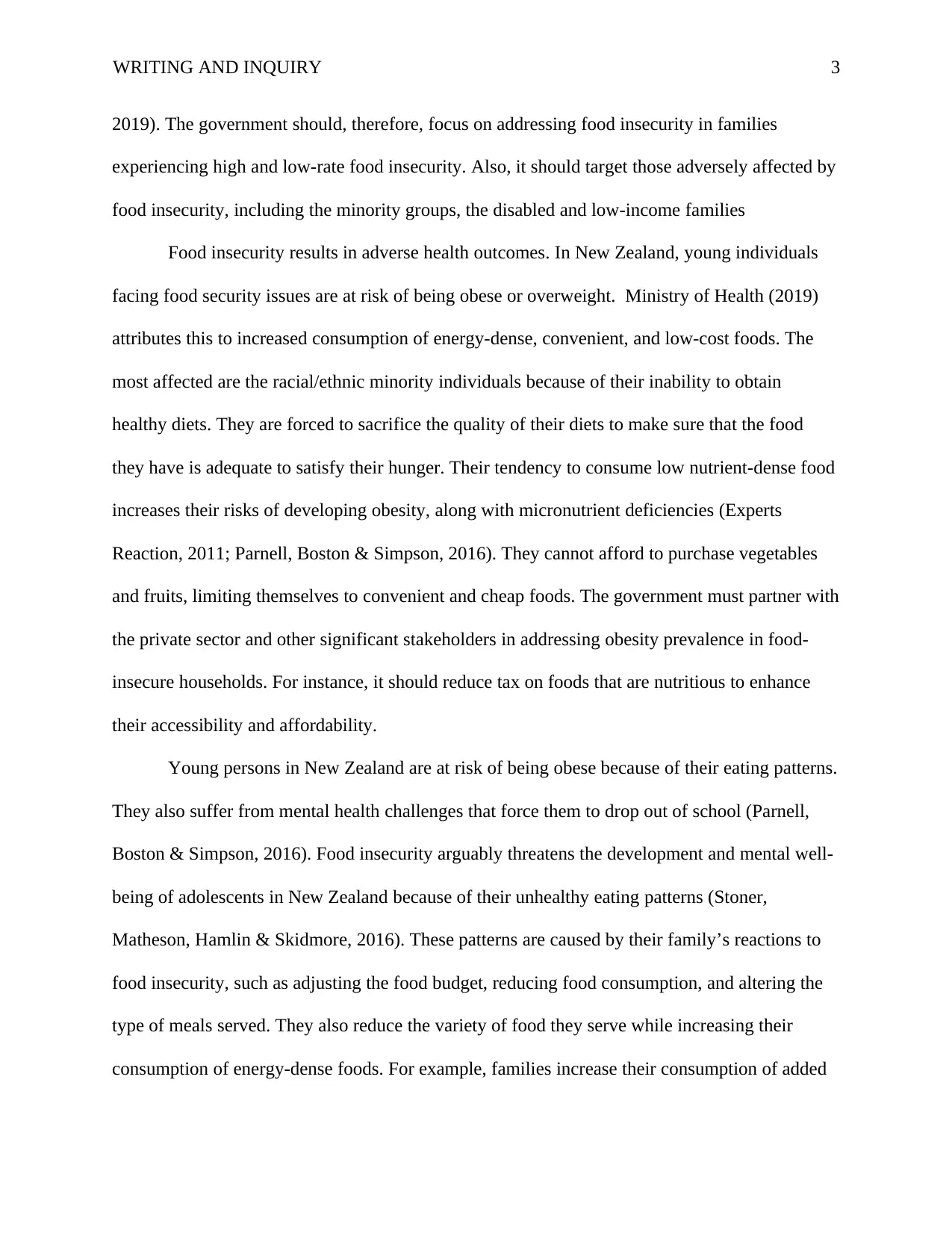
WRITING AND INQUIRY 3
2019). The government should, therefore, focus on addressing food insecurity in families
experiencing high and low-rate food insecurity. Also, it should target those adversely affected by
food insecurity, including the minority groups, the disabled and low-income families
Food insecurity results in adverse health outcomes. In New Zealand, young individuals
facing food security issues are at risk of being obese or overweight. Ministry of Health (2019)
attributes this to increased consumption of energy-dense, convenient, and low-cost foods. The
most affected are the racial/ethnic minority individuals because of their inability to obtain
healthy diets. They are forced to sacrifice the quality of their diets to make sure that the food
they have is adequate to satisfy their hunger. Their tendency to consume low nutrient-dense food
increases their risks of developing obesity, along with micronutrient deficiencies (Experts
Reaction, 2011; Parnell, Boston & Simpson, 2016). They cannot afford to purchase vegetables
and fruits, limiting themselves to convenient and cheap foods. The government must partner with
the private sector and other significant stakeholders in addressing obesity prevalence in food-
insecure households. For instance, it should reduce tax on foods that are nutritious to enhance
their accessibility and affordability.
Young persons in New Zealand are at risk of being obese because of their eating patterns.
They also suffer from mental health challenges that force them to drop out of school (Parnell,
Boston & Simpson, 2016). Food insecurity arguably threatens the development and mental well-
being of adolescents in New Zealand because of their unhealthy eating patterns (Stoner,
Matheson, Hamlin & Skidmore, 2016). These patterns are caused by their family’s reactions to
food insecurity, such as adjusting the food budget, reducing food consumption, and altering the
type of meals served. They also reduce the variety of food they serve while increasing their
consumption of energy-dense foods. For example, families increase their consumption of added
2019). The government should, therefore, focus on addressing food insecurity in families
experiencing high and low-rate food insecurity. Also, it should target those adversely affected by
food insecurity, including the minority groups, the disabled and low-income families
Food insecurity results in adverse health outcomes. In New Zealand, young individuals
facing food security issues are at risk of being obese or overweight. Ministry of Health (2019)
attributes this to increased consumption of energy-dense, convenient, and low-cost foods. The
most affected are the racial/ethnic minority individuals because of their inability to obtain
healthy diets. They are forced to sacrifice the quality of their diets to make sure that the food
they have is adequate to satisfy their hunger. Their tendency to consume low nutrient-dense food
increases their risks of developing obesity, along with micronutrient deficiencies (Experts
Reaction, 2011; Parnell, Boston & Simpson, 2016). They cannot afford to purchase vegetables
and fruits, limiting themselves to convenient and cheap foods. The government must partner with
the private sector and other significant stakeholders in addressing obesity prevalence in food-
insecure households. For instance, it should reduce tax on foods that are nutritious to enhance
their accessibility and affordability.
Young persons in New Zealand are at risk of being obese because of their eating patterns.
They also suffer from mental health challenges that force them to drop out of school (Parnell,
Boston & Simpson, 2016). Food insecurity arguably threatens the development and mental well-
being of adolescents in New Zealand because of their unhealthy eating patterns (Stoner,
Matheson, Hamlin & Skidmore, 2016). These patterns are caused by their family’s reactions to
food insecurity, such as adjusting the food budget, reducing food consumption, and altering the
type of meals served. They also reduce the variety of food they serve while increasing their
consumption of energy-dense foods. For example, families increase their consumption of added
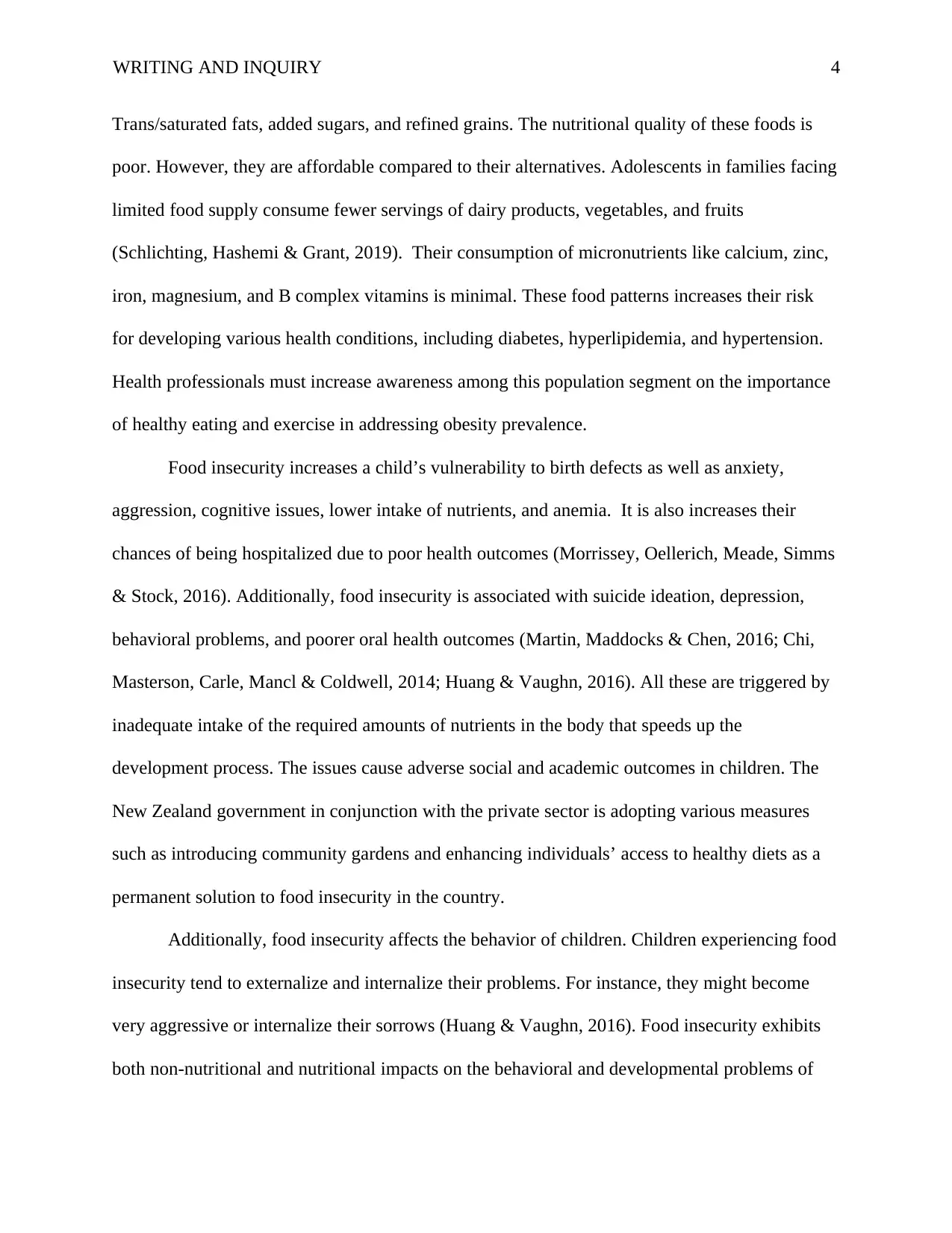
WRITING AND INQUIRY 4
Trans/saturated fats, added sugars, and refined grains. The nutritional quality of these foods is
poor. However, they are affordable compared to their alternatives. Adolescents in families facing
limited food supply consume fewer servings of dairy products, vegetables, and fruits
(Schlichting, Hashemi & Grant, 2019). Their consumption of micronutrients like calcium, zinc,
iron, magnesium, and B complex vitamins is minimal. These food patterns increases their risk
for developing various health conditions, including diabetes, hyperlipidemia, and hypertension.
Health professionals must increase awareness among this population segment on the importance
of healthy eating and exercise in addressing obesity prevalence.
Food insecurity increases a child’s vulnerability to birth defects as well as anxiety,
aggression, cognitive issues, lower intake of nutrients, and anemia. It is also increases their
chances of being hospitalized due to poor health outcomes (Morrissey, Oellerich, Meade, Simms
& Stock, 2016). Additionally, food insecurity is associated with suicide ideation, depression,
behavioral problems, and poorer oral health outcomes (Martin, Maddocks & Chen, 2016; Chi,
Masterson, Carle, Mancl & Coldwell, 2014; Huang & Vaughn, 2016). All these are triggered by
inadequate intake of the required amounts of nutrients in the body that speeds up the
development process. The issues cause adverse social and academic outcomes in children. The
New Zealand government in conjunction with the private sector is adopting various measures
such as introducing community gardens and enhancing individuals’ access to healthy diets as a
permanent solution to food insecurity in the country.
Additionally, food insecurity affects the behavior of children. Children experiencing food
insecurity tend to externalize and internalize their problems. For instance, they might become
very aggressive or internalize their sorrows (Huang & Vaughn, 2016). Food insecurity exhibits
both non-nutritional and nutritional impacts on the behavioral and developmental problems of
Trans/saturated fats, added sugars, and refined grains. The nutritional quality of these foods is
poor. However, they are affordable compared to their alternatives. Adolescents in families facing
limited food supply consume fewer servings of dairy products, vegetables, and fruits
(Schlichting, Hashemi & Grant, 2019). Their consumption of micronutrients like calcium, zinc,
iron, magnesium, and B complex vitamins is minimal. These food patterns increases their risk
for developing various health conditions, including diabetes, hyperlipidemia, and hypertension.
Health professionals must increase awareness among this population segment on the importance
of healthy eating and exercise in addressing obesity prevalence.
Food insecurity increases a child’s vulnerability to birth defects as well as anxiety,
aggression, cognitive issues, lower intake of nutrients, and anemia. It is also increases their
chances of being hospitalized due to poor health outcomes (Morrissey, Oellerich, Meade, Simms
& Stock, 2016). Additionally, food insecurity is associated with suicide ideation, depression,
behavioral problems, and poorer oral health outcomes (Martin, Maddocks & Chen, 2016; Chi,
Masterson, Carle, Mancl & Coldwell, 2014; Huang & Vaughn, 2016). All these are triggered by
inadequate intake of the required amounts of nutrients in the body that speeds up the
development process. The issues cause adverse social and academic outcomes in children. The
New Zealand government in conjunction with the private sector is adopting various measures
such as introducing community gardens and enhancing individuals’ access to healthy diets as a
permanent solution to food insecurity in the country.
Additionally, food insecurity affects the behavior of children. Children experiencing food
insecurity tend to externalize and internalize their problems. For instance, they might become
very aggressive or internalize their sorrows (Huang & Vaughn, 2016). Food insecurity exhibits
both non-nutritional and nutritional impacts on the behavioral and developmental problems of
Secure Best Marks with AI Grader
Need help grading? Try our AI Grader for instant feedback on your assignments.
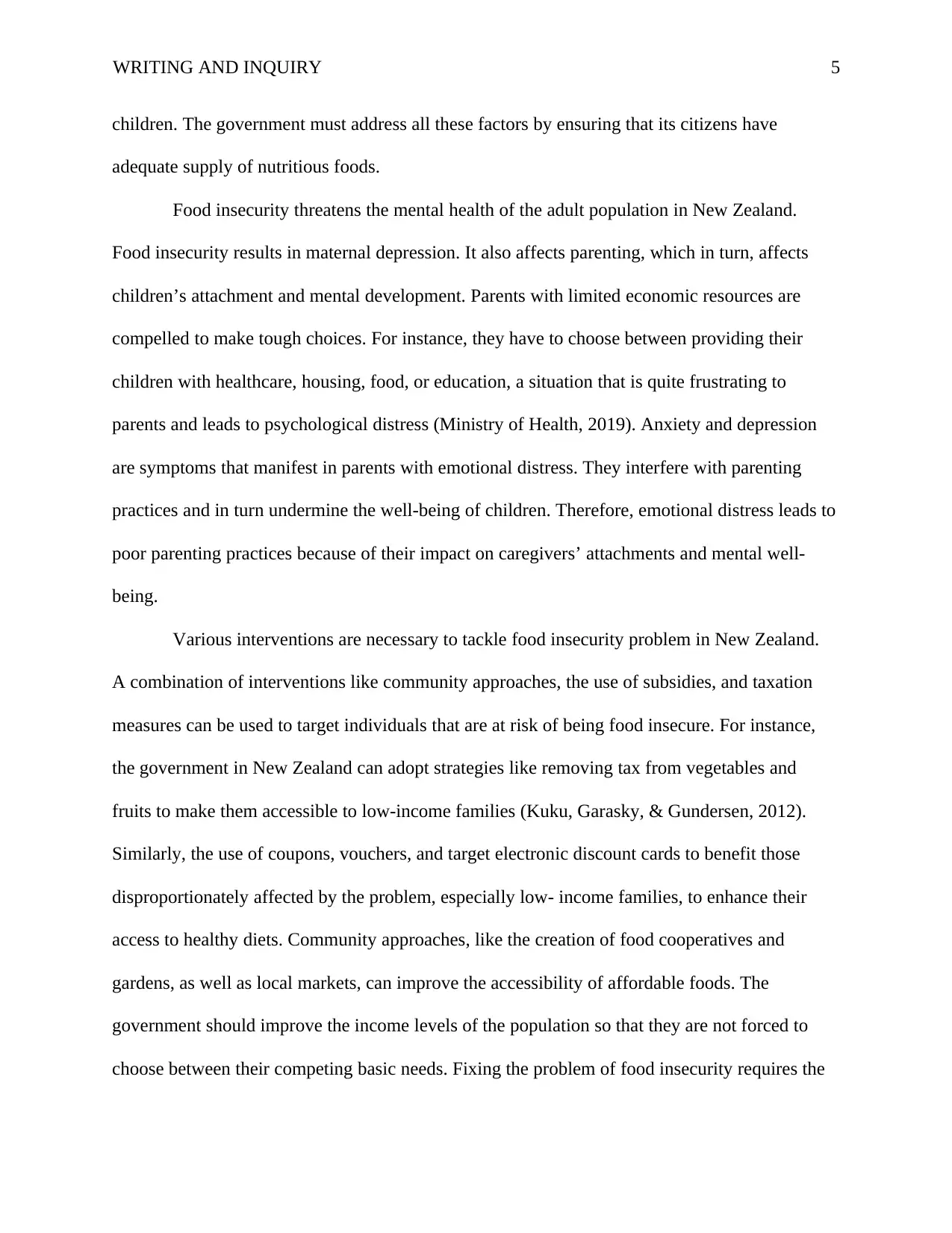
WRITING AND INQUIRY 5
children. The government must address all these factors by ensuring that its citizens have
adequate supply of nutritious foods.
Food insecurity threatens the mental health of the adult population in New Zealand.
Food insecurity results in maternal depression. It also affects parenting, which in turn, affects
children’s attachment and mental development. Parents with limited economic resources are
compelled to make tough choices. For instance, they have to choose between providing their
children with healthcare, housing, food, or education, a situation that is quite frustrating to
parents and leads to psychological distress (Ministry of Health, 2019). Anxiety and depression
are symptoms that manifest in parents with emotional distress. They interfere with parenting
practices and in turn undermine the well-being of children. Therefore, emotional distress leads to
poor parenting practices because of their impact on caregivers’ attachments and mental well-
being.
Various interventions are necessary to tackle food insecurity problem in New Zealand.
A combination of interventions like community approaches, the use of subsidies, and taxation
measures can be used to target individuals that are at risk of being food insecure. For instance,
the government in New Zealand can adopt strategies like removing tax from vegetables and
fruits to make them accessible to low-income families (Kuku, Garasky, & Gundersen, 2012).
Similarly, the use of coupons, vouchers, and target electronic discount cards to benefit those
disproportionately affected by the problem, especially low- income families, to enhance their
access to healthy diets. Community approaches, like the creation of food cooperatives and
gardens, as well as local markets, can improve the accessibility of affordable foods. The
government should improve the income levels of the population so that they are not forced to
choose between their competing basic needs. Fixing the problem of food insecurity requires the
children. The government must address all these factors by ensuring that its citizens have
adequate supply of nutritious foods.
Food insecurity threatens the mental health of the adult population in New Zealand.
Food insecurity results in maternal depression. It also affects parenting, which in turn, affects
children’s attachment and mental development. Parents with limited economic resources are
compelled to make tough choices. For instance, they have to choose between providing their
children with healthcare, housing, food, or education, a situation that is quite frustrating to
parents and leads to psychological distress (Ministry of Health, 2019). Anxiety and depression
are symptoms that manifest in parents with emotional distress. They interfere with parenting
practices and in turn undermine the well-being of children. Therefore, emotional distress leads to
poor parenting practices because of their impact on caregivers’ attachments and mental well-
being.
Various interventions are necessary to tackle food insecurity problem in New Zealand.
A combination of interventions like community approaches, the use of subsidies, and taxation
measures can be used to target individuals that are at risk of being food insecure. For instance,
the government in New Zealand can adopt strategies like removing tax from vegetables and
fruits to make them accessible to low-income families (Kuku, Garasky, & Gundersen, 2012).
Similarly, the use of coupons, vouchers, and target electronic discount cards to benefit those
disproportionately affected by the problem, especially low- income families, to enhance their
access to healthy diets. Community approaches, like the creation of food cooperatives and
gardens, as well as local markets, can improve the accessibility of affordable foods. The
government should improve the income levels of the population so that they are not forced to
choose between their competing basic needs. Fixing the problem of food insecurity requires the
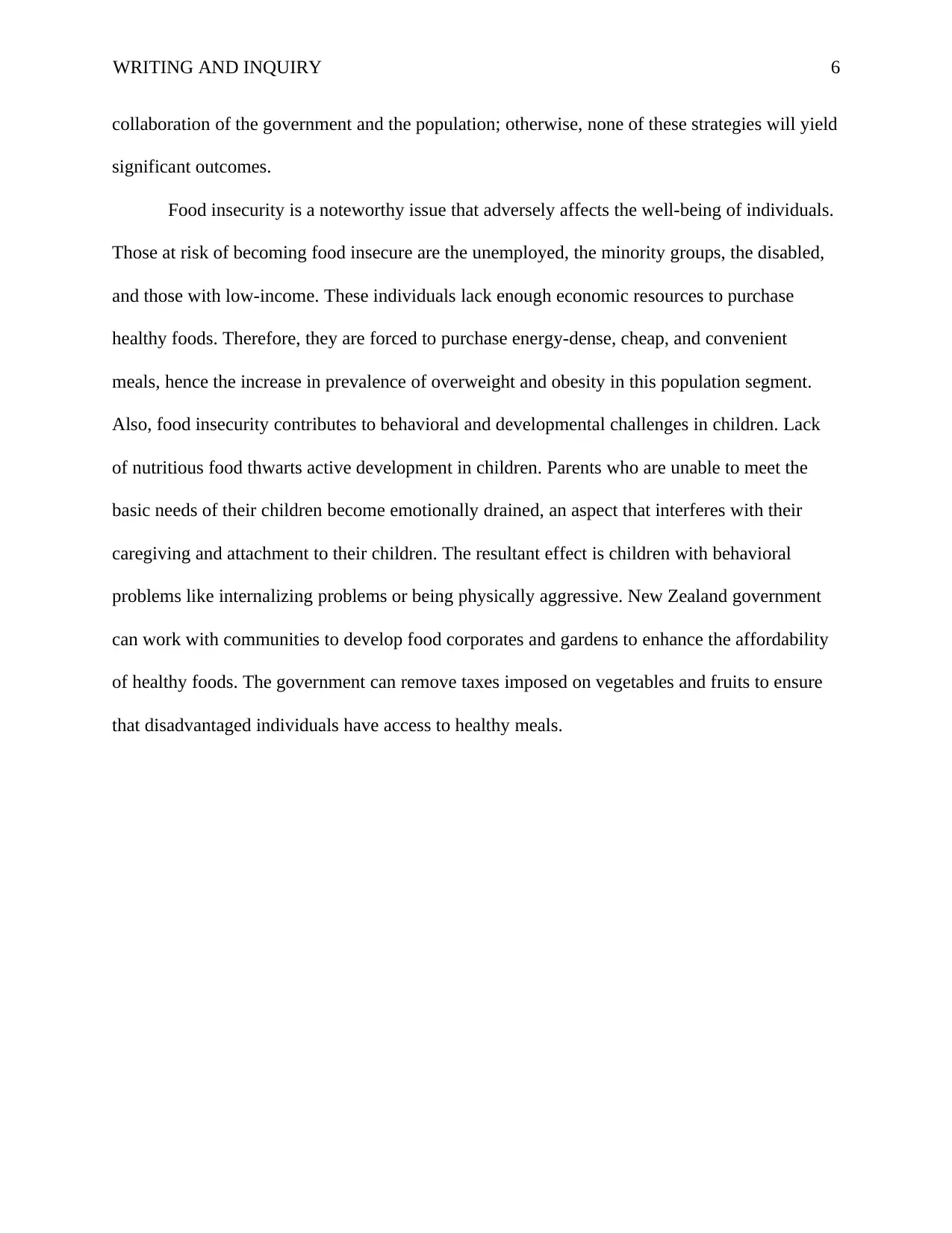
WRITING AND INQUIRY 6
collaboration of the government and the population; otherwise, none of these strategies will yield
significant outcomes.
Food insecurity is a noteworthy issue that adversely affects the well-being of individuals.
Those at risk of becoming food insecure are the unemployed, the minority groups, the disabled,
and those with low-income. These individuals lack enough economic resources to purchase
healthy foods. Therefore, they are forced to purchase energy-dense, cheap, and convenient
meals, hence the increase in prevalence of overweight and obesity in this population segment.
Also, food insecurity contributes to behavioral and developmental challenges in children. Lack
of nutritious food thwarts active development in children. Parents who are unable to meet the
basic needs of their children become emotionally drained, an aspect that interferes with their
caregiving and attachment to their children. The resultant effect is children with behavioral
problems like internalizing problems or being physically aggressive. New Zealand government
can work with communities to develop food corporates and gardens to enhance the affordability
of healthy foods. The government can remove taxes imposed on vegetables and fruits to ensure
that disadvantaged individuals have access to healthy meals.
collaboration of the government and the population; otherwise, none of these strategies will yield
significant outcomes.
Food insecurity is a noteworthy issue that adversely affects the well-being of individuals.
Those at risk of becoming food insecure are the unemployed, the minority groups, the disabled,
and those with low-income. These individuals lack enough economic resources to purchase
healthy foods. Therefore, they are forced to purchase energy-dense, cheap, and convenient
meals, hence the increase in prevalence of overweight and obesity in this population segment.
Also, food insecurity contributes to behavioral and developmental challenges in children. Lack
of nutritious food thwarts active development in children. Parents who are unable to meet the
basic needs of their children become emotionally drained, an aspect that interferes with their
caregiving and attachment to their children. The resultant effect is children with behavioral
problems like internalizing problems or being physically aggressive. New Zealand government
can work with communities to develop food corporates and gardens to enhance the affordability
of healthy foods. The government can remove taxes imposed on vegetables and fruits to ensure
that disadvantaged individuals have access to healthy meals.
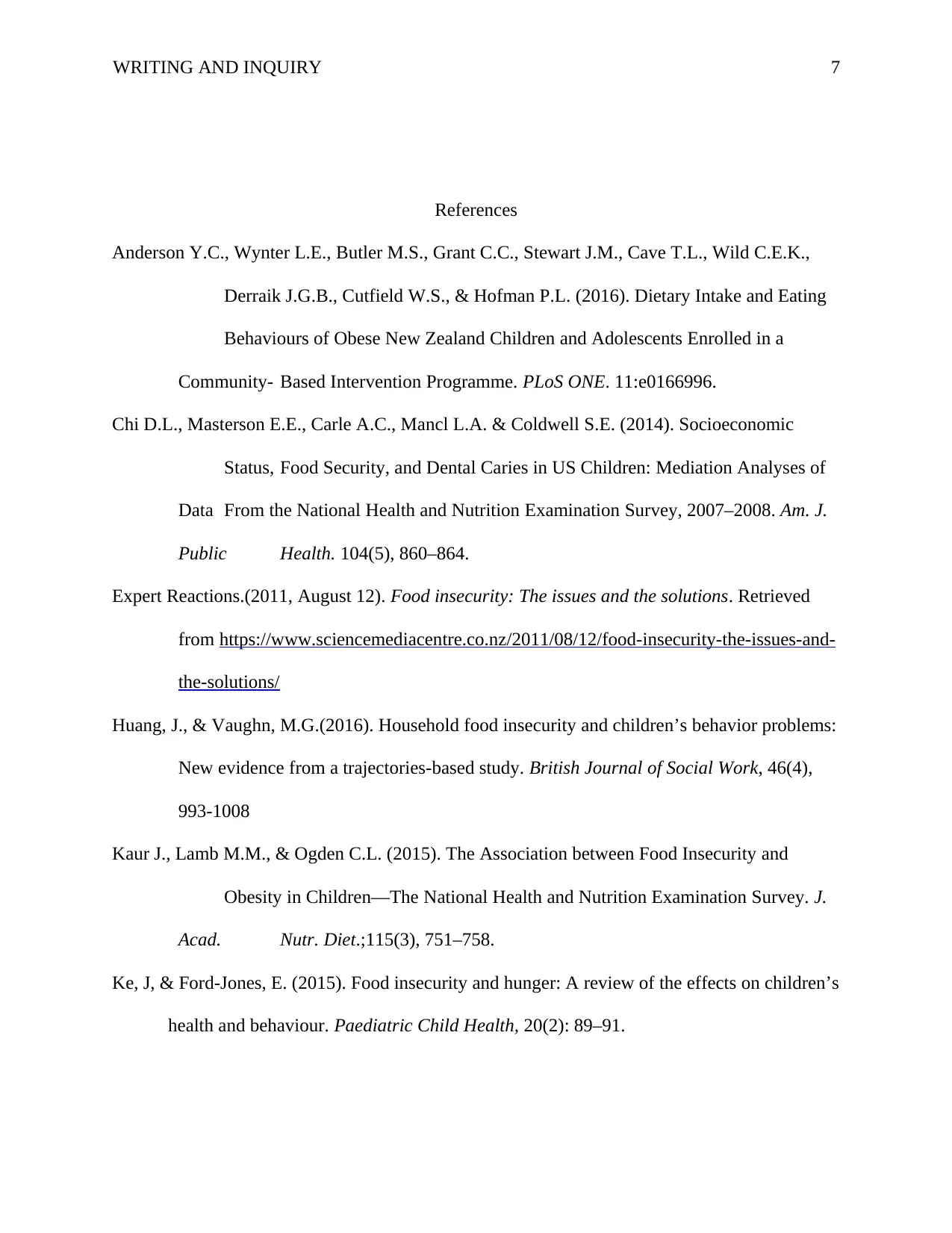
WRITING AND INQUIRY 7
References
Anderson Y.C., Wynter L.E., Butler M.S., Grant C.C., Stewart J.M., Cave T.L., Wild C.E.K.,
Derraik J.G.B., Cutfield W.S., & Hofman P.L. (2016). Dietary Intake and Eating
Behaviours of Obese New Zealand Children and Adolescents Enrolled in a
Community- Based Intervention Programme. PLoS ONE. 11:e0166996.
Chi D.L., Masterson E.E., Carle A.C., Mancl L.A. & Coldwell S.E. (2014). Socioeconomic
Status, Food Security, and Dental Caries in US Children: Mediation Analyses of
Data From the National Health and Nutrition Examination Survey, 2007–2008. Am. J.
Public Health. 104(5), 860–864.
Expert Reactions.(2011, August 12). Food insecurity: The issues and the solutions. Retrieved
from https://www.sciencemediacentre.co.nz/2011/08/12/food-insecurity-the-issues-and-
the-solutions/
Huang, J., & Vaughn, M.G.(2016). Household food insecurity and children’s behavior problems:
New evidence from a trajectories-based study. British Journal of Social Work, 46(4),
993-1008
Kaur J., Lamb M.M., & Ogden C.L. (2015). The Association between Food Insecurity and
Obesity in Children—The National Health and Nutrition Examination Survey. J.
Acad. Nutr. Diet.;115(3), 751–758.
Ke, J, & Ford-Jones, E. (2015). Food insecurity and hunger: A review of the effects on children’s
health and behaviour. Paediatric Child Health, 20(2): 89–91.
References
Anderson Y.C., Wynter L.E., Butler M.S., Grant C.C., Stewart J.M., Cave T.L., Wild C.E.K.,
Derraik J.G.B., Cutfield W.S., & Hofman P.L. (2016). Dietary Intake and Eating
Behaviours of Obese New Zealand Children and Adolescents Enrolled in a
Community- Based Intervention Programme. PLoS ONE. 11:e0166996.
Chi D.L., Masterson E.E., Carle A.C., Mancl L.A. & Coldwell S.E. (2014). Socioeconomic
Status, Food Security, and Dental Caries in US Children: Mediation Analyses of
Data From the National Health and Nutrition Examination Survey, 2007–2008. Am. J.
Public Health. 104(5), 860–864.
Expert Reactions.(2011, August 12). Food insecurity: The issues and the solutions. Retrieved
from https://www.sciencemediacentre.co.nz/2011/08/12/food-insecurity-the-issues-and-
the-solutions/
Huang, J., & Vaughn, M.G.(2016). Household food insecurity and children’s behavior problems:
New evidence from a trajectories-based study. British Journal of Social Work, 46(4),
993-1008
Kaur J., Lamb M.M., & Ogden C.L. (2015). The Association between Food Insecurity and
Obesity in Children—The National Health and Nutrition Examination Survey. J.
Acad. Nutr. Diet.;115(3), 751–758.
Ke, J, & Ford-Jones, E. (2015). Food insecurity and hunger: A review of the effects on children’s
health and behaviour. Paediatric Child Health, 20(2): 89–91.
Paraphrase This Document
Need a fresh take? Get an instant paraphrase of this document with our AI Paraphraser
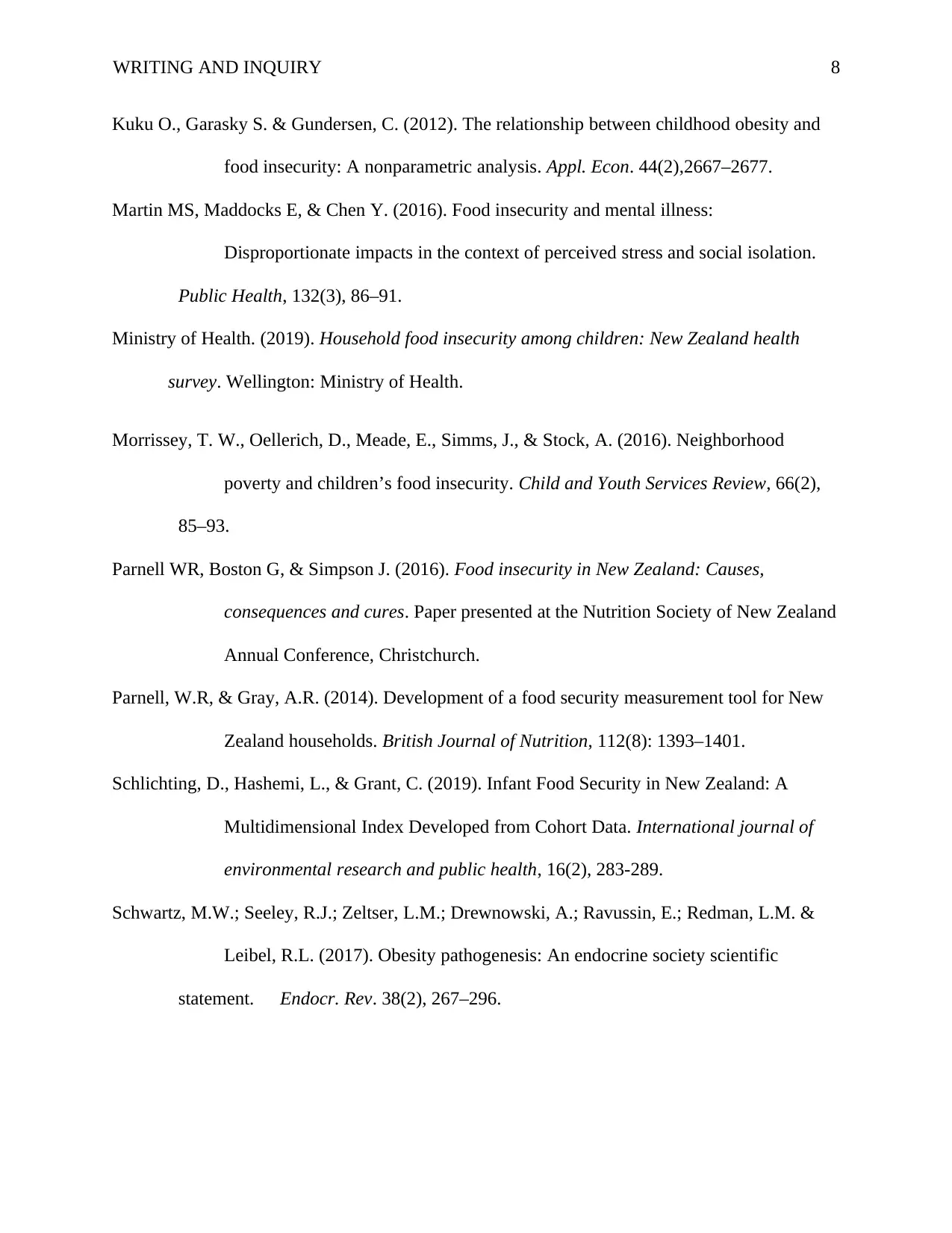
WRITING AND INQUIRY 8
Kuku O., Garasky S. & Gundersen, C. (2012). The relationship between childhood obesity and
food insecurity: A nonparametric analysis. Appl. Econ. 44(2),2667–2677.
Martin MS, Maddocks E, & Chen Y. (2016). Food insecurity and mental illness:
Disproportionate impacts in the context of perceived stress and social isolation.
Public Health, 132(3), 86–91.
Ministry of Health. (2019). Household food insecurity among children: New Zealand health
survey. Wellington: Ministry of Health.
Morrissey, T. W., Oellerich, D., Meade, E., Simms, J., & Stock, A. (2016). Neighborhood
poverty and children’s food insecurity. Child and Youth Services Review, 66(2),
85–93.
Parnell WR, Boston G, & Simpson J. (2016). Food insecurity in New Zealand: Causes,
consequences and cures. Paper presented at the Nutrition Society of New Zealand
Annual Conference, Christchurch.
Parnell, W.R, & Gray, A.R. (2014). Development of a food security measurement tool for New
Zealand households. British Journal of Nutrition, 112(8): 1393–1401.
Schlichting, D., Hashemi, L., & Grant, C. (2019). Infant Food Security in New Zealand: A
Multidimensional Index Developed from Cohort Data. International journal of
environmental research and public health, 16(2), 283-289.
Schwartz, M.W.; Seeley, R.J.; Zeltser, L.M.; Drewnowski, A.; Ravussin, E.; Redman, L.M. &
Leibel, R.L. (2017). Obesity pathogenesis: An endocrine society scientific
statement. Endocr. Rev. 38(2), 267–296.
Kuku O., Garasky S. & Gundersen, C. (2012). The relationship between childhood obesity and
food insecurity: A nonparametric analysis. Appl. Econ. 44(2),2667–2677.
Martin MS, Maddocks E, & Chen Y. (2016). Food insecurity and mental illness:
Disproportionate impacts in the context of perceived stress and social isolation.
Public Health, 132(3), 86–91.
Ministry of Health. (2019). Household food insecurity among children: New Zealand health
survey. Wellington: Ministry of Health.
Morrissey, T. W., Oellerich, D., Meade, E., Simms, J., & Stock, A. (2016). Neighborhood
poverty and children’s food insecurity. Child and Youth Services Review, 66(2),
85–93.
Parnell WR, Boston G, & Simpson J. (2016). Food insecurity in New Zealand: Causes,
consequences and cures. Paper presented at the Nutrition Society of New Zealand
Annual Conference, Christchurch.
Parnell, W.R, & Gray, A.R. (2014). Development of a food security measurement tool for New
Zealand households. British Journal of Nutrition, 112(8): 1393–1401.
Schlichting, D., Hashemi, L., & Grant, C. (2019). Infant Food Security in New Zealand: A
Multidimensional Index Developed from Cohort Data. International journal of
environmental research and public health, 16(2), 283-289.
Schwartz, M.W.; Seeley, R.J.; Zeltser, L.M.; Drewnowski, A.; Ravussin, E.; Redman, L.M. &
Leibel, R.L. (2017). Obesity pathogenesis: An endocrine society scientific
statement. Endocr. Rev. 38(2), 267–296.
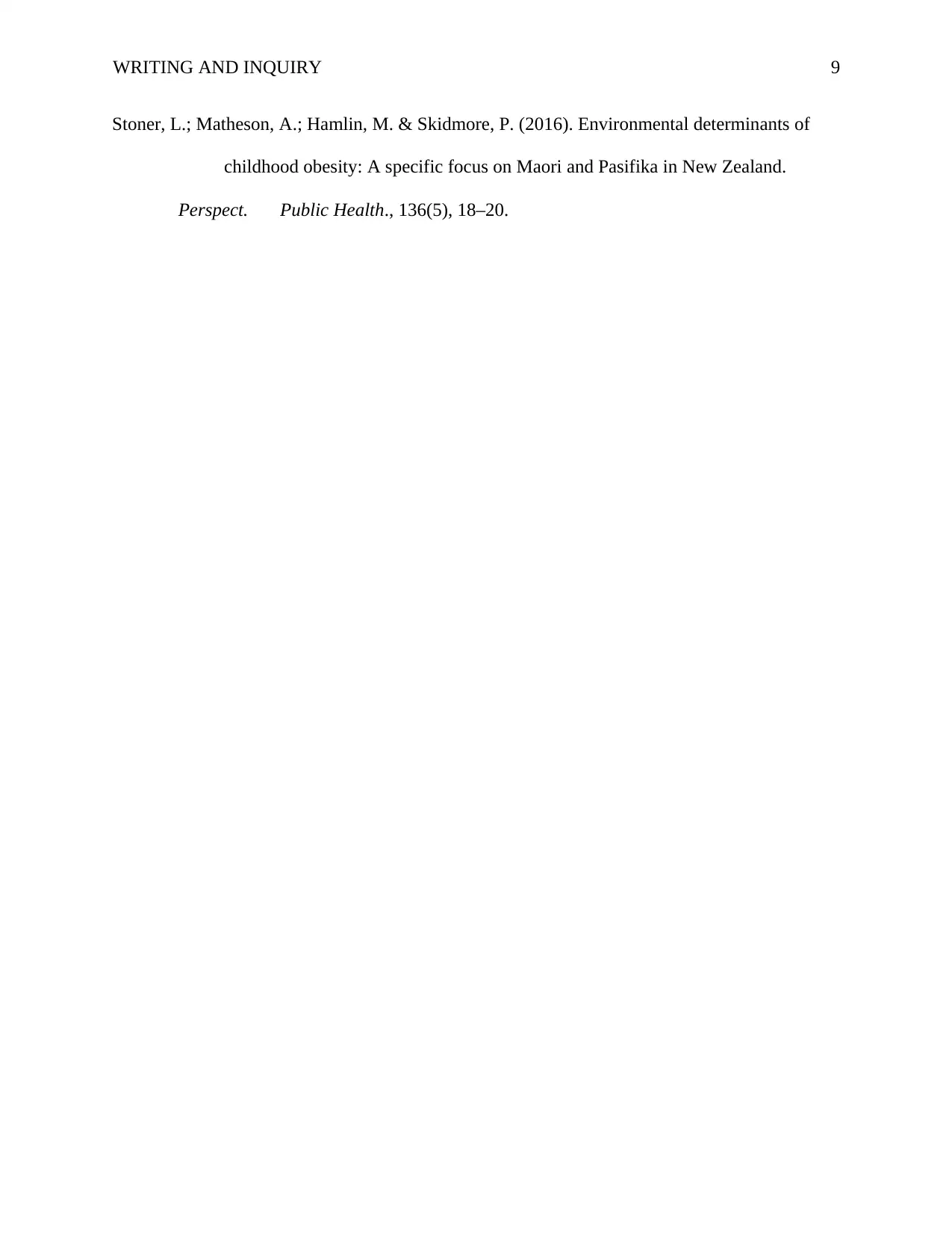
WRITING AND INQUIRY 9
Stoner, L.; Matheson, A.; Hamlin, M. & Skidmore, P. (2016). Environmental determinants of
childhood obesity: A specific focus on Maori and Pasifika in New Zealand.
Perspect. Public Health., 136(5), 18–20.
Stoner, L.; Matheson, A.; Hamlin, M. & Skidmore, P. (2016). Environmental determinants of
childhood obesity: A specific focus on Maori and Pasifika in New Zealand.
Perspect. Public Health., 136(5), 18–20.
1 out of 9
Your All-in-One AI-Powered Toolkit for Academic Success.
+13062052269
info@desklib.com
Available 24*7 on WhatsApp / Email
![[object Object]](/_next/static/media/star-bottom.7253800d.svg)
Unlock your academic potential
© 2024 | Zucol Services PVT LTD | All rights reserved.